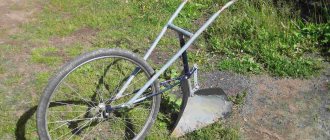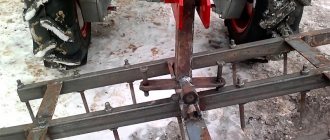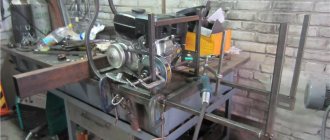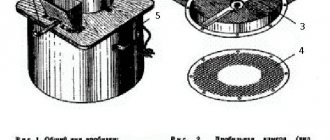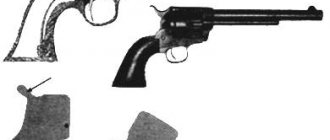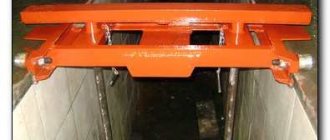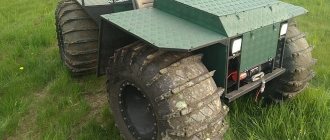The bulk of Russians' garden space is traditionally allocated to potatoes, because our people also call it the second bread. Many have transferred part of the labor of growing potatoes onto their shoulders, or rather onto trailed small-scale mechanization equipment: walk-behind tractors and mini tractors.
And if planting potatoes is not a big job, then hilling them, and most importantly, digging them up is not an easy task. For hilling and weeding, the hiller included with walk-behind tractors is most often used, but for digging in its pure form it is not entirely suitable. Let's figure out what to dig and how to make a potato digger for a walk-behind tractor with your own hands.
There are several known designs of potato diggers for walk-behind tractors and mini tractors. Let's look at them: from the simplest to the most technologically advanced.
Fan potato diggers
The simplest ones to manufacture are also produced industrially, but most require some modifications.
It is immediately clear that they are based on the same hiller; it is this hiller, buried below the level of the tubers, that loosens and turns the soil. But he brings up the dug potatoes - a fan welded to the back of the hiller. Its role is played by metal rods, welded at a distance of 3–4 cm from each other, diverging and curved in the upper part.
The amount of depth is regulated by thrust wheels, and the transverse bar serves as a footrest, upon which a person, with his weight, provides the required depth to the device.
It is this type of fan potato digger that seems to us to be the most productive. The digging process itself can be seen here:
You will have to modify the shape, angle of attack and other nuances yourself, taking into account your soil, the power and driving performance of the walk-behind tractor on which you plan to install the potato digger, and even the varieties of potatoes that form tubers at different depths.
A type of similar digger without a fan, designed for two people:
Potato diggers with a roar
This is the most common type of potato digger, produced by various machine-building plants in Russia and abroad. It has slight design differences, primarily in the design of the screen drive - oscillating during operation of the pan, which allows the potatoes to be partially cleared of the soil while the potato digger is moving.
The knife of such a digger can have different configurations. It can be fixed motionless, or it can be hinged and oscillate slightly during movement, simplifying the process of digging up tubers. The width of the knife is 35 – 40 cm.
How to install adjusting rods
Adjustment rods are not a necessary part of the potato digger. So, if you plan to work exclusively in dry climates, then you don’t have to worry about their availability. But if you have to harvest tubers after a rainstorm, you will need such traction. They perform the functions of adjusting the tilt of the rods. And, if it is necessary to install rods, the strip should be welded directly to the rod, and not to the risers.
The rod must be welded to the first cross member on the frame. You will be able to unscrew the rod, it, in turn, will lengthen and extend the rods. This will make the angle of inclination not so significant. The use of 2 rods will ensure better fixation of the reinforcement during operation. And if you twist the rods back, the angle of departure of the potatoes will increase, and they will be better cleared of black soil.
DIY drawings
It is this type of potato digger, despite being quite difficult to manufacture, that is made by home craftsmen with their own hands more often than others. We offer approximate drawings with the main dimensions of such a potato digger for a walk-behind tractor.
A large number of joints of moving parts makes this device regularly serviced, but the result of its work is of better quality than that of fan-shaped potato diggers:
Potatoes are peeled better from the ground and are located on its surface.
The magnitude and frequency of oscillations of the screen may vary and depend on the design of the drive, but even with minor oscillations, cleaning occurs quite well:
How to attach a potato digger to a walk-behind tractor?
The possibility of attaching a potato digger to a walk-behind tractor completely depends on the design and the unit used - the following general points can be highlighted:
- The main condition for normal operation is the power ratio between the walk-behind tractor and the unit. In practice, this means that it is not advisable to attach a powerful walk-behind tractor to weak fan-shaped potato diggers.
- Size ratio. Aspect ratio is one of the key parameters during installation. When making a potato digger yourself, you need to decide on the purchase of a walk-behind tractor (if you don’t have one), and then, according to the drawings, make the mechanism in relation to the parameters of the walk-behind tractor.
- Correspondence between the potato digger mount and the walk-behind tractor mount. The main thing when making a structure is to correlate the mounting of the walk-behind tractor and the structure itself.
A potato digger is a good helper for summer residents due to its efficiency. With economical fuel consumption, it is possible to quickly process a large sown area and with low yield loss, while the time taken is much faster than when working with a shovel.
Conveyor potato diggers
They are much easier to make yourself, but in our opinion they are no worse at peeling potatoes from soil.
Their knives are the same as those of the screening ones, and the potatoes are peeled while they move along the conveyor belt. It is clear that the longer it is, the better the potatoes will be peeled, but long conveyor belts can only be installed on potato diggers used with tractors. On walk-behind tractors, they will interfere with the person walking behind him.
The conveyor belt drive may be different. If it is taken from the wheels of the digger itself, then they must have good lugs so that they do not lock on wet or very loose soil.
Also interesting in this design are the rear guides, which more compactly place the potatoes behind the belt.
In this self-assembled conveyor potato digger, the belt drive is carried out from the power take-off shaft of a homemade walk-behind tractor and is transmitted by a motorcycle chain.
To view a picture, click on its thumbnail on the right
When manufacturing a potato digger of this type, the main problem will be selecting the rotation speed of the conveyor drive gear and matching it with the speed of the power take-off shaft. In this model, the power take-off shaft rotates at a speed of 500 - 800 rpm, and the gearbox is taken from a motor boat with a gear ratio of approximately 1:2. The rest is selected by the size of the stars for an approximate walking speed when digging 2-3 km/h.
And yet, the connection between the speed of the conveyor belt and the wheel speed seems more appropriate to us.
There are models designed for specific walk-behind tractors and mini tractors, like this one for mechanisms with a side power take-off shaft:
Drum potato diggers
This is a rather rare type of equipment for mini-equipment, so it is mostly homemade. Peeling potatoes from soil in such devices occurs quite efficiently, as does laying them on the ground, but the design itself is quite controversial, and the tubers are more damaged than when digging with the above-mentioned potato diggers, and therefore are worse preserved.
What is simpler about them is the direct drive of rotation from the power take-off shaft. Everything else: making the drum, thrust rollers and bearings is clearly more complicated. The design of the knife does not have any special features, except that it is preferable for it to have a more rounded shape in the back so that the potatoes are not further damaged when they get into the drum.
Horse-mounted potato digger
There are still quite a lot of them for sale on the Internet. They are imported mainly from Poland and converted into mini tractors and walk-behind tractors.
At the same time, taking into account the higher speed of movement of this equipment in comparison with a horse, in addition to modifying the towing device, a limiter-shield is placed on it on the side on which the dug potatoes are thrown. Otherwise, it will have to be collected in neighboring areas. A wedge-shaped paw digs up the potatoes, as in fan diggers, and the drive of the device that removes the tubers from the ground is carried out by wheels with lugs. The higher the travel speed, the faster this potato extractor rotates.
Dear readers, if you have any questions, please ask them using the form below. We will be glad to communicate with you;)
Attachments for different types of equipment cost an impressive amount of money.
That is why one of the options to save money is to make it yourself, from scrap and purchased materials.
One of the most popular additional devices for a mini-tractor or walk-behind tractor is a homemade potato digger.
It allows you to fully automate the process of harvesting potatoes, which is extremely labor-intensive if done manually.
Types of potato diggers
Such units differ in size, working width and design features. If you are interested in a homemade potato digger, then first consider the features of each type of such device. The most popular are screening and fan units, but more experienced craftsmen are able to make drum and conveyor potato diggers. More details about the types of construction:
- Fan (lancet). Due to the characteristic shape of the plow, manufacturers often call this type of unit “Dolphin”. This is the simplest version of a potato digger and is inexpensive. It easily adapts to any model of mini-tractor or walk-behind tractor. There are no movable parts in the design. The principle of operation is that the soil with tubers is cut with a knife, after which the cut falls on the surface of the rods, where the soil is poured back. In this case, the tubers in their pure form lie on top of the soil. This type of digger is good for soil with low density, but it has relatively low efficiency - it lifts about 85% of the crop to the top.
- Vibrating (screening). Compared to the previous ones, they are more effective - they extract up to 98% of tubers from the soil. The mechanism of operation is as follows: the top layers along with the potatoes are picked up and placed on a vibrating table. Then, under the influence of vibration, the soil begins to peel off and escape through the cracks. The potatoes will fall out on the other side of the device. This potato digger is also suitable for collecting other vegetables. The downside is the complexity of manufacturing.
- Transporter. They can freely work on the basis of such walk-behind tractors as “Neva”. The design is very similar to vibration devices - they consist of a ploughshare and a moving conveyor. The latter has a special hooking device that supports the tubers on the platform and clears them of soil. The conveyor unit is more practical than the vibrating unit. The downside is that it is not practical to use on lightly compacted soil. It costs more than its fan counterpart.
- Drums. A potato digger equipped with a drum is used to process fields using a mini tractor. The mechanism of action involves the rotation of a lattice structure, due to which the potato tubers are cleared of soil. But users of the drum potato digger note that the potato peel is damaged in the drum. Homemade devices of this type are rare, because their manufacture is not an easy task, because it involves studying diagrams and drawings.
Where to begin?
Do not rush headlong into tools and pieces of metal. First of all, you should decide on some very important points.
- What type of equipment will the potato digger be used with?
- How much can be spent on this event?
- What type of potato digger and according to what drawings will it be assembled?
- How will the individual parts be connected?
- Where and how will materials for construction be selected?
Connection method - welding or bolt-nut?
There are two ways to connect individual parts of metal structures (sheets, corners and others) that you will have to use when constructing a potato digger.
Contact welding method using electricity or gas
– more aesthetically pleasing, but less reliable in most cases.
If there is a large load on the structure, which may occur when used on hard and rocky soil, there is a possibility of the seam between the metal structures breaking.
Another way is using a bolt, locknuts and nuts.
Using such fasteners, you can connect the metal structure quite firmly.
A bolted connection has other advantages over a welded seam.
If necessary, the structure can be easily disassembled - for example, if you need to transport a potato digger over a long distance.
To connect individual parts you do not need special equipment: a drill, a drill bit and a pair of keys are enough.
Useful tips on the topic
Useful tips that will come in handy when making and using a homemade potato digger:
- To bend a metal plate or other element of the device, it is first heated using a gas burner. After obtaining the desired shape, the part is hardened.
- It is advisable to prepare a drawing of the device and all significant components in advance.
- Beginners are advised to first transfer all dimensions from the drawing to cardboard and assemble the model. Only after this start cutting metal. This technique helps to clearly see all the problem areas.
- During testing of the finished device, a test pass is made. You only need to travel a few meters to see how well or poorly the potato digger works. If necessary, change the angle of inclination and depth of immersion.
- Proper configuration of the device increases productivity to the maximum.
What is needed to assemble a homemade potato digger?
The basis of this type of attachment is usually a welded frame made of metal corners. The thickness of the metal is selected taking into account the load it will experience.
The larger it is, the thicker the sheet of metal should be. The most commonly used corners are those with overall dimensions of 63×40 mm. You will also need an iron channel made of durable metal.
Ideally for this case, a part marked with number 8 is suitable. In addition, sheets of metal of various sizes, with a thickness of at least 8 mm, are required.
If everything will be connected with bolts, you should purchase the required amount of hardware.
You will also need:
- a chain that will transmit torque;
- wheels - metal or rubber, depending on the type of soil on which you will have to work;
- metal drum;
- gas pipe with a diameter of ¼.
How to make wheels
Now it's a matter of small things. For an almost finished potato digger, you need wheels. As a basis, you can find any unnecessary cart that could transport 100 kg. You will need to take 2 wheels from it. We make and weld mounts in the shape of the letter “L” to each wheel. It’s even better if the wheels already have an axle. Then you need to saw off each wheel with a 5 centimeter piece. It is to the axle that we weld the stand.
Drill 10 mm holes in the racks at a distance of 4 cm. It is in them that the so-called "finger" . Those. These holes will be locking ones. After completing all these steps, you will have a convenient accessory for the walk-behind tractor - a potato digger. And you will save more than 10 thousand rubles.
Operating principle and assembly of a homemade potato digger
The operating principle of a potato digger is quite simple.
The design contains two steel knives that cut the ground. Afterwards, they collect the tubers along with the soil and feed it all along a special transport grid into a collection bunker.
The lattice moves and vibrates, as a result of which the stuck clods of earth are easily separated from the potato tubers.
If there is a lack of material, the bunker can not be made, and the potatoes, cleared of adhering soil, can be dumped directly on the field. Then it is simply assembled by hand.
Assembling the potato digger is carried out in several stages. They are all equally important, each detail performs its function.
The stronger all connections are made, the longer the assembled device will last.
First of all, the frame is assembled from corners and metal channels. It is the supporting basis of the entire structure. After its assembly, all other components are attached to the frame.
One of the largest and most important parts of a potato digger is the elevator.
It consists of a vibrating grid on which the potatoes are fed, and high metal sides made of thick sheet metal.
The entire elevator structure is welded or bolted from metal angles.
The elevator is equipped with special shafts, which transmit the force from the rotating wheels - it causes the grate to vibrate.
After the elevator is completely assembled and fixed to the supporting frame of the potato digger, a ploughshare is attached to it. This is a plow, which is the direct working part that turns potato tubers out of the ground.
It can be made from a variety of metal objects. Both from a real, most ordinary plow, and from a specially sharpened and curved piece of pipe with a diameter of 200 mm.
It is advisable to attach the ploughshare to the elevator using bolts, since this part of the potato digger experiences the greatest load during operation. 10mm bolts are exactly what is needed in this case.
The penultimate stage is the design and assembly of the support and transport unit. It consists of wheels, discs to which they will be attached, two roller chains and a metal rod. There are also sprockets and bearings.
All these assembled parts will make moving the potato digger during operation extremely simple and easy. Roller chains are used to transmit rotation to special shafts that create vibration on the elevator grate.
The sprockets are mounted on a metal rod, which acts as a bridge and rotates as it moves. Metal disks are welded to the rod, and wheels are subsequently attached to them.
Special attention should be paid to the method of connecting the equipment to the agricultural machinery that will set it in motion.
The construction of this device is the last stage in assembling a potato digger with your own hands.
If you have any attachments for a tractor or walk-behind tractor, you should simply make a structurally similar mount.
Although some well-known manufacturers of mini tractors create an individual and rather complex system for connecting attachments.
In this case, you should show engineering thought and find an approach to solve this problem. Perhaps a way out of the situation could be to make changes to the design of the tractor itself.
Build process
The assembly process is regulated by basic rules, as well as the features of the device. Each type of mechanism has its own order and assembly conditions. With the exception of the standard rules, several conditions must be met:
- the connection of structural elements is carried out on the basis of an existing platform or eye;
- Initially, it is the supporting structural element that is installed;
- the parts are adjusted in accordance with the parameters indicated in the drawing or diagram;
- the assembly process is divided into stages, depending on the complexity of the design;
- The last stage is fitting the design to the equipment and a test run.
The last stage in the assembly is the most important, as it allows you to eliminate deficiencies before the main work process begins.
The most difficult option is to create a homemade screening (vibrating structure). Self-assembly process:
- the first stage is considered the moment of creating the frame;
- the frame is constructed from 4 corners: 2 – 0.8 m each, 2 – 1.2 m each;
- Several jumpers are attached to the resulting rectangle, through which the equipment is controlled thanks to vertical traction;
- a shaft for the wheel system is attached;
- several racks and a metal sheet are installed on them;
- after this, a lattice base is created;
- The last step is to install the wheels and adjusting rods.
A potato planter on a walk-behind tractor is considered ready after checking the operation, and not after securing the entire structure.
With small errors in calculations, the design may have defects or the tuber assembly process may be carried out incorrectly. If you do not follow the established calculations and circuit parameters, then installing the mechanism on the equipment itself will become problematic. During the manufacturing process, it is necessary to constantly check the dimensions with the required dimensions.
This is interesting: a disc hiller for the Neva MB 2 walk-behind tractor.
Most homemade options have a simpler collection pattern than the type presented. For example, the fan type, that is, an ordinary lancet potato planter on a walk-behind tractor, is easy to assemble. A knife is installed on a base, including corners and several fasteners, which is surrounded by rows of metal pins. The main point is the correct placement of the rods, as this will affect the efficiency of the assembly.
Many types of home-made structures are universal and differ from conveyor models only in parameters and dimensions.
Collecting root crops using a walk-behind tractor and devices installed on it is preferable to the manual method. You can either purchase a potato digger for a specific model of equipment, or you can design it yourself. Each type of mechanism has its own characteristics and difficulties in manufacturing.
Thickness of the metal used to assemble the potato digger
The optimal metal thickness that should be used for this type of homemade equipment is 5-7 mm. It is this size that guarantees fairly high strength and not excessive weight.
If the work of harvesting potatoes will have to be done on land that has excess moisture, then the lighter the machine, the better. In this case, you can use material of smaller thickness.
If the soil is hard and rocky, then the greater the weight of the potato digger, the better. With its weight it will create the force necessary for work.
It will be easier for the ploughshare to cut into the ground and turn the layers of earth outward along with the potato tubers.
How to set up and adjust a potato digger on a walk-behind tractor
When starting the potato digger for the first time, it is necessary to adjust the depth of immersion of the plowshares into the ground. According to the standards, the knife of the device must enter the soil below the level of the fruit. Thus, the crop will not be damaged and will be delivered to the top layer of soil intact. The optimal immersion depth is 12-15 cm.
The knife is adjusted using the hitch bracket and support wheels. With a shorter length of the racks, the stroke depth increases, otherwise it decreases.
What wheels to use to construct a homemade potato digger
For the type of equipment under consideration, three types of wheels can be used:
- rubber with regular tread;
- rubber with tractor tread;
- metal.
Each type has both its advantages and disadvantages. The use of any of them is fully justified in different cases.
If the soil is wet and loose and easily collapses under heavy weight, you should focus on rubber wheels.
They are quite light, and the tractor tread of the rubber tires will easily rake the ground, which will allow the equipment to move off without difficulty, without slipping or getting stuck.
Also, when designing a potato digger, you should choose the widest possible wheels, otherwise movement will be somewhat difficult.
Metal wheels are perfect for working on hard ground.
They will significantly increase the overall weight of the structure, which in this case is only beneficial: it will be easier for the plow to stick into the ground and perform its function.
It is also advisable to choose a tractor tread for all-metal wheels in order to avoid getting stuck and skidding when driving on loose and marshy soil.
The principle of potato diggers
Almost the same simple principle is used to dig up potatoes. The ploughshare plunges into the ground and digs up root crops mixed with stones (if there are any on the site) and earth.
As it moves, the mixture hits the digging machine, which clears the soil and gradually moves it back until it falls to the ground. After this, it can be collected from the ground surface.
The following describes how the basic structures that make up a homemade potato digger can be made.
Some people make a potato digger from a hiller with their own hands.
Finger drum
If possible, a finger drum can be installed on the elevator. It is a piece of pipe onto which fingers of the required length are welded.
The part should be of such a size that it does not reach the grill by just a couple of centimeters. The drum is mounted on a special axis, which has a welded sprocket.
Using a chain drive, the drum axis is connected to the wheel shaft.
If everything is done correctly and the calculations are correct, your fingers will break up the hard, dried soil, which falls along with the tubers onto the elevator grate. As a result, the potatoes will be as free as possible from adhering soil.
To make this option you will need:
large diameter pipe cut- round sheets of metal
, which will subsequently cover both holes in the pipe; - steel rod
, which will serve as an axis of rotation; - long cylindrical metal fingers
(you can use reinforcement used to reinforce concrete).
The entire structure is manufactured using resistance welding.
Buying a factory potato digger is a very expensive undertaking. Therefore, if you don’t have extra money and have a lot of time, as well as a well-working head and hands, you can easily save a decent amount.
After watching the video, we can conclude that it is important to be careful and conscientious about your work, then a homemade potato digger will be able to serve you without breakdowns or downtime for a very long time:
Probably, every owner of a large personal plot or vegetable garden wants to minimize the labor intensity of land work and reduce the time of tillage to a minimum, which is why gardeners strive to acquire a walk-behind tractor and various equipment for it. If you are the happy owner of this useful equipment and like to grow a lot of potatoes on your plot, then it makes sense to think about the need for a potato digger for mechanical harvesting. Now you can buy various designs and improved equipment for all types of walk-behind tractors, or you can put in a little effort and make a digger for a walk-behind tractor with your own hands. In this article we will introduce you to the varieties of this device and tell you how to make a potato digger yourself.
Do-it-yourself potato digger - design features
There are two types of household potato diggers:
simple and vibration. The principle of operation of potato diggers of all types is the same - the rawl, ploughshare or tines are immersed in the soil and extract potato tubers onto its surface. Thus, the gardener will not need to manually dig out potatoes from each hole - the gardening unit will do it for him. Both types of diggers can be made independently from available materials or you can buy some components, the cost of which is low, and save your budget.
Simple digger
is an attachment in the form of a pointed curved iron sheet to which rods are welded in a fan-shaped manner. This mini-ploughshare cuts the soil and lifts the tubers along an expanding fan of twigs, while sifting out excess soil. A simple digger, which is attached to a walk-behind tractor, mechanizes potato harvesting.
The vibrating digger
is a conveyor potato digger for use when working with a walk-behind tractor. Complete with screening grid and wheels. The harvesting mechanism with such a digger is simple: the soil is cut with a rake, which goes along with the potato tubers onto a grid, where the root crops are sifted from the clods of earth and then rolled along the screening grid to the soil surface.
Important! It makes sense to make a potato digger yourself for cultivating areas with light and medium-heavy soils.
How to make a potato digger with your own hands: choosing material and tools
In order to make a regular homemade potato digger for a walk-behind tractor, you will need the following materials:
- frame made of welded corners, the size of which is 40 by 40 mm;
- sections of pipe or channel 1.3 m long;
- fittings with a diameter of 10 mm;
- metal sheet with a thickness of 7 mm or more for the sides of the fence and ploughshare;
- pieces of square pipes or channels for metal racks - 8-10 pieces;
- rotary metal drum and chain for transmitting rotation;
- wheels, bolts and hardware.
Did you know?
A vibrating potato digger for a walk-behind tractor ensures harvesting up to 95% of the entire potato harvest, and a simple fan one – up to 85%.
Equipment and tools needed to create a potato digger with your own hands:
- welding machine;
- drill and drill bits;
- metal scissors;
- hammer, wrenches;
- Bulgarian.
Potato Digger
This potato digging unit is also called a vibrating potato digger or shaking digger. A potato peeler consists of three parts: a knife, a moving grid with mechanisms that ensure its vibration, and a metal frame (frame).
A potato digger can be manufactured within a few hours; the work requires experience and skill in working with agricultural machinery. To make the unit you will need:
- Bulgarian;
- welding machine;
- drill, metal drills;
- metal profile with a square side of 2.5 cm;
- steel sheet 3-5 mm thick;
- steel wire with a diameter of 8 mm (or non-corrugated reinforcement of the same diameter);
- wheels;
- bolts, hinges, levers, eccentric, measuring tape, consumables.
Features of making a simple potato digger
A simple potato digger is an improved curved shovel that plunges into the ground below the level of potato tubers and pushes them to the surface. By correctly calculating the width of the digger and the angle of inclination of the cutting tool, during harvesting you can loosen the soil, which will not need digging. Making a simple potato digger is simple - three sheets of iron are welded together and attached to the walk-behind tractor with a special fastener. The simplicity of the design and the small number of component parts allow it to be manufactured by a novice agricultural machine operator who knows how to work with a welding machine.
How to make a hiller
The simplest hiller is the lister type, which consists of two peak-shaped welded wings made of sheet iron with a thickness of at least 2-3 mm. This device has a fixed grip length due to fixed elements, the tip of which pierces and loosens the ground, so every gardener planning to make a simple potato digger with his own hands must first make drawings of the device, taking into account the row spacing that is acceptable for him, which he usually maintains when planting potatoes. As a rule, this is about 60 cm, and industrial hillers are only 30 cm wide. To make a hiller, you need to take a sheet of metal at least 3 mm thick, triangular in shape, the base length of which is from 30 to 60 cm, and the height is about 30 cm. This element The hiller is bent along the height of the triangle, thereby creating a point that pierces the ground; small rectangles in the form of wings are welded to it, the span of which will be equal to the width of the rows. 7-10 rods approximately 30 cm long are welded to the main triangle in a fan-shaped manner. For better rigidity, the tip of the triangle is reinforced with an iron strip no less than 3 mm thick.
Important!
A rigid stand-mount will prevent overloading the walk-behind tractor engine during operation.
Attaching the potato digger
To attach the potato digger to the walk-behind tractor, you will need a metal rectangle 50*520 mm, the metal thickness of which is at least 10 mm. Holes are drilled on it to regulate the depth of immersion of the digging tip into the ground to avoid cutting the tubers. It makes sense to strengthen the rigidity of the tip and wings by connecting the edges of the wings with an iron plate, to which a structural post will be welded, bearing the entire load of earthworks when harvesting potatoes; if possible, this metal part can be pre-hardened.
What is a potato digger and its types
A potato digger is an agricultural technique used by farmers and private farmers to simplify the process of harvesting potatoes.
Main parts of a potato digger for a walk-behind tractor with your own hands:
- base - the metal base of the potato digger: this is a frame made of heavy-duty thick metal;
- the traction mount is responsible for fastening the mechanism's rods;
- vertical stands - needed to secure the knife-ploughshare on them;
- ploughshare - the main element of a potato digger, is a knife that goes deep into the ground, loosening the soil;
- adjusting rods - designed to adjust the angle of attack of the ploughshare;
- support wheels - necessary for moving the potato digger across the cultivated area.
Potato diggers for mini tractors are used on loose, medium-compacted soil.
Note! Regardless of the type, the operation of all devices is similar: the tool goes deep into the ground with its pointed part, moving along the beds, lifting soil layers with potato tubers.
There are the following potato diggers for the walk-behind tractor:
- fan-shaped (lancet);
- conveyor;
- vibrodynamic (screening).
Assembling a garden shredder with your own hands
Fan
A homemade fan potato digger for a walk-behind tractor is universal. The potato digger is structurally very simple. Its mechanism does not have rotating parts, which in other potato diggers quickly fail under heavy loads during harvesting. This species has other names: because of its characteristic appearance, they are called “paw” or pointed, and the industrial model is called Dolphin.
From experience with fan models for tractors, farmers using this type:
- ability to work with low-power walk-behind tractors;
- ease of connection with a walk-behind tractor;
- relatively low prices for industrial models;
- reliability;
- good cleaning speed.
The disadvantages of working with fan potato diggers include:
- the likelihood of loss of the potato crop occurs due to the small working width of the digger;
- part of the crop may be damaged by a knife, making it unusable.
Conveyor
The design of the conveyor potato digger for the walk-behind tractor is simple. In the center of the mechanism there is a transport belt, with the help of which the harvested crop of root crops moves upward along the belt, being cleared of dirt and adhering soil. The conveyor belt moves in a circle using the power from the rotating element of the walk-behind tractor through chains, a variator, and gears. You can make a potato digger with your own hands, but you need to follow the technique.
Advantages of a conveyor digger:
- does not damage potatoes;
- ease of operation;
- Compatible with high-power walk-behind tractors and small tractors.
The disadvantages of a conveyor CC include the likelihood of foreign objects getting into the conveyor, which can jam the mechanism and damage it.
Grohotnaya
The design of the vibrating CC, also called “screening”, is simple - the device consists of 3 parts:
- ploughshare;
- a movable grid with a vibrating mechanism that processes the harvested crop;
- metal carcass.
This type of CC is used in agricultural production for harvesting potatoes from large areas, sometimes on an industrial scale. The unit works like this: collecting and sifting tubers on a vibrating table is carried out through vibrations coming from a screening mechanism.
The advantages of using this unit include:
- wide coverage of the cultivated strip of soil;
- large depth of immersion of the knife into the ground;
- minor losses of potatoes during harvesting.
There are also disadvantages to using vibrating diggers:
- vibrations from the screening mechanism enter the control part of the walk-behind tractor, the impact of the vibration mechanism tires the body;
- Before working with CC, S-cleaning must be cleared of foreign plants that could clog the grate.
How to make a screen-type potato digger with your own hands
Making a potato screening type digger with your own hands is a little more complicated, but very realistic to implement. First, you need to make the individual components of this useful unit, connect them together, check the operation of the mechanism, and the do-it-yourself vibrating potato digger for a walk-behind tractor is ready for harvesting potatoes. Let's study all the stages of making a potato digger for a walk-behind tractor. Before manufacturing this mechanism, it is recommended to make a schematic drawing of a potato digger for a walk-behind tractor, indicating the dimensions of the parts for clarity when measuring the material and further welding work.
To begin with, it is recommended to make a frame for the screen digger. To do this, you should weld a rectangle measuring 120*80 cm from a square pipe of 40*40 mm (or corners), which needs to be well sanded with a grinder. Then a section of 40*40 mm square pipe is welded to a quarter of the length of this frame rectangle for a jumper and further installation of rods. In another part of the frame we make a mount for the wheel axle; to do this, from the outside in the corners, we need to vertically position and weld two 15 cm long pipes with a diameter of 30 mm, and use a drill to drill a hole with a diameter of 10 mm in each pipe.
Then you should install several vertical posts - to do this, you need to step back 5 cm from the built-in jumpers on both sides and weld them in a square measuring 3*3 cm and 50 cm long, then step back another 20 cm and weld 40 cm posts, after which step back 40 cm and weld 30 cm posts, the result will be a kind of ladder. Now you need to connect the racks with a metal strip, the thickness of which is 0.4 mm, at an angle of 45 degrees, the result is a triangular structure.
Did you know?
The first horse-drawn potato digger was created by a Russian blacksmith in 1847.
How to make a pitched board and ralo
The next stage of making a potato digger with your own hands is welding the working part of our device - the raal and the pitched board. Ralo is necessary for digging potato tubers from the soil and then feeding them onto a ramp made of iron rods. For the construction of the rahl, two metal sheets measuring 400 * 400 mm, 0.3 mm thick, are needed, in each of which you need to make a hole for a bolt, and also drill a hole in the racks, stepping back 5 cm from the edge, and firmly screw these metal plates to frame with bolts. Then a metal plate measuring 30*70 cm is bent cone-shaped in the central part using hammer blows and butt-welded to the side sheets - it turns out to be a rawl, the edge of which needs to be sharpened for better penetration into the ground.
The pitched board is welded from 8-10 metal rods or pieces of reinforcement approximately 1.2 m long, one end of which is welded below to the raft, and the second extends beyond the boundaries of the digger and moves quite freely.
The rods are welded parallel at a distance of about 40 mm. To strengthen the structure, a channel about 30 cm long can be welded at the end of the frame on both sides - these will be risers to which the bar is welded.
Rods will then be welded to it at a distance of two-thirds of their length to strengthen the pitched board. During the harvesting process, the free edges of the rods will vibrate and break the soil adhering to the root crops. It is also recommended to weld metal plates on the side of the bars of the pitched board to prevent potato tubers from falling out of the lattice structure.
Selection of wheels for the design
We have already familiarized ourselves with the main steps of how to make a potato digger with our own hands; now we need to choose wheels for the design from the following options:
- metal – suitable for use on hard soil, their weight makes the digger heavier and improves the work of the rake;
- simple rubber ones - used for working on loose soil; on wet soil they will not make it possible to transport garden equipment;
- rubber ones with a tractor tread - will make it possible to use the structure in wet soil without slipping; they are bulky and heavy.
Rubber wheels with tractor tread are the best option for making a potato digger. The wheel is equipped with a mount shaped like the letter “G”, which is attached to an axle mounted on the frame of the digger. The wheel can be fixed with a “pin” by analogy with a garden wheelbarrow.
Important!
Wider wheels will make it easier to move the potato digger around garden beds.
Making fasteners
And here we are at the final stage of making a potato digger with our own hands - making the mount and final assembly of the mechanism. The gearbox unit is attached to the axle using bearings, and the transport mechanism is assembled from wheels, roller chains, and metal disks. The axle, as a connecting bridge, should be attached with sprockets; discs are welded to it, to which the wheels are attached. The chain will transmit energy and rotate the shafts, driving the potato digger mechanism.
Then a holder is made with the letter “G”. The long end is attached to a radial part connected to the walk-behind tractor, and the short end is welded to the tip of the rahl. To control the angle of the rafter, the best option would be to connect the beam to the potato digger with two or more bolts.
As a result of all the work done, you will have a potato digger for a walk-behind tractor, very easy to use, in addition, it will be partially dismountable and transportable due to the mechanism being bolted together. This potato digger will help remove potato tubers from the soil, clear a little of the soil and carefully place them on the surface of the furrows. The owner of a personal plot will only have to harvest the crop and provide it with optimal conditions for storage.
Was this article helpful? Not really
For those who know first-hand what it is to work in the field, grow your own potato crop, and even more so harvest it, understand what a difficult task it is. It’s good that after a long time of this practice, a person came up with a simple invention to facilitate potato harvesting - a do-it-yourself potato digger
. In this case, our grandfathers used an ordinary shovel, and this mechanical device was created specifically to automate the collection of potatoes. The function of a potato digger is to separate tubers from the soil and place them on the surface of the field.
Of course, there are factory versions of this device, but for a more or less experienced gardener it will not be difficult to assemble a potato digger yourself, which will be little inferior to these samples.
Potato digger design
The simple design makes it much easier. It is based on a welded frame, which is assembled from a special corner measuring 63x40 mm, an iron channel number 8, and 8 mm metal plates. A ploughshare is made from the plates, which in principle can be made from an ordinary circular saw. The ploughshare is attached to the elevator casing with 4 bolts tightened with nuts. Thanks to the round sharpening of the part, potato tubers are almost impossible to cut.
The tilt of the elevator can be changed by changing the fastening of the casing to the frame, and at the same time the angle at which the opener digs also changes. The editorial unit is made from two cylindrical metal bodies. They have the form of a glass and a bushing and connect two shafts made of steel - the drive and the driven. These shafts should rotate without difficulty, and special sprockets with welded hubs are mounted on prismatic keys. As a rule, they are made from a piece of gas pipeline measuring approximately 25 mm.
potato digger for a mini tractor can do without a cleaning drum.
, however, creating it is the most difficult part in making a potato digger. Its design includes two roller chains with 94 links, mounted on rods. This design, due to its shape, was called the “squirrel wheel”. This wheel is mounted on two bent disks for strength. In some cases, a bicycle wheel rim is used instead of disks. The “squirrel wheel” is welded to the disks and fixed on two fixed welded axles, on which it then rotates. The shaft rotates on the bearings, and with it the driven sprockets rotate, on which the rotation of the drum itself depends.
The best material for a slider so that the chain-bar tape can easily slide over it is fluoroplastic. The tape itself looks like a “squirrel wheel”, but the rods on it are shorter and there are fewer of them. Sliders are also needed to protect the chain from damage and act as a support.
The easiest part of making a potato digger is its support and transport unit. Each person makes it according to his own calculations. Usually there are no special difficulties in creating it. By the way, similar mechanisms are used in
It is worth making a manual potato digger for compact areas. It is better to buy industrial types of equipment for large areas from manufacturers.
Simple vibration equipment can be easily made from the following materials:
- Iron channel.
- The pieces of steel were no thinner than 5 millimeters. Strong steel will be required for the plowshare. A used blade from a circular saw or any other high-speed steel is perfect.
- Iron corners from rolled metal.
- Steel or iron rods. It is better to use fittings of small diameter.
The vibration model must be made from a base or frame. The design must include:
- base (the above-mentioned frame);
- suspension system;
- rods for adjustment;
- moving elements (wheels or lugs).
Drawing of a vibrating potato digger for a walk-behind tractor:
Potato digger for a walk-behind tractor using a screening crop separator
This design is more complex to manufacture, but the performance is 2-3 times higher than the previous model. If your vegetable garden planted with potatoes has an area of several hundred square meters, it makes sense to spend time creating an effective device. It will pay for itself in the effort saved during harvesting.
For production you will need:
- Profiled pipe for making a frame;
- Steel sheet 3-4 mm thick for the ladle;
- Circle or reinforcement made of ordinary steel;
- Channel 30-30 mm for vertical rods;
- The front hub is from any rear-wheel drive car, from the same Zhiguli;
- Gearbox from the rear axle of a VAZ classic;
- Cardan shaft (if connected to the power take-off shaft);
- Spline connection from an old gearbox;
- Wheel from old agricultural machinery (you can buy ready-made);
- Welding machine, grinder, drill;
- Fastening elements.
A potato digger for a walk-behind tractor of this design rests independently on the ground with the help of one or two wheels. The operating principle is shown in the illustration:
The supporting frame has two support points. The suspension for the walk-behind tractor is a traction device. Support wheels regulate the height of the structure above the field.
The gearbox is driven by the power take-off shaft of the walk-behind tractor, or connected to the wheels of the potato digger. The rod, one end connected to the crank mechanism, performs oscillatory movements.
The spline drives the ploughshare (moves back and forth like an excavator bucket) and the screen (moves sideways like a dog's tail). As a result, each portion of dug potatoes is separated from the soil and collected in a lattice storage tank.
If the drive has a positive tilt angle, you can periodically stop the movement and unload the peeled potatoes into bags. Or set a negative angle, then the tubers will be evenly unloaded on top of the soil for subsequent drying and harvesting.
Important! if it is necessary to harvest potatoes in wet soil (for example, after rain), you need to change the angle of work and the depth of immersion of the ploughshare.
To do this, provide an adjusting screw rod.
If such a design is too complex to implement, a simpler one can be made, with the same vibration separator. A homemade potato digger gives a lot of scope for creative thought. This design sifts the crop along the movement of the walk-behind tractor. The bucket ploughshare scoops the potatoes into the grate, which makes a reciprocating movement back and forth. For this purpose, the suspension is made on swinging hinges.
The vibrator drive itself is made of a pipe and an eccentric connected by a shaft to a pulley. The pulley (located on top of the frame in the illustration) is connected to the wheel using a belt drive. Or, using an angular gearbox, it can be connected to the power take-off shaft of your walk-behind tractor.
The sifted potatoes are shipped to the bed behind the device. Or, as it accumulates, you can stop the movement and load the crop into containers.
Conclusion: the listed structures are actually made from rubbish, which is present in any farmstead. If there is a need to purchase any components, they will not greatly increase the cost of the structure. Especially in comparison with the factory copy.
Important! A homemade potato digger can cause injury
Therefore, when operating, take basic precautions.. Potato digger for walk-behind tractor, video instructions for detailed manufacturing
Potato digger for walk-behind tractor, video instructions for detailed production.
The potato digger for the walk-behind tractor is a mounted device and is used together with the walk-behind tractor. The efficiency of its work is high. It is capable of cultivating not only a plot of land, but also a field. Its main function is to separate tubers from the soil and then lay them on the surface of the site.
Work on creating a vibration model
Rules for manufacturing each part separately and assembling the entire mechanism.
The basis
It is optimal to use a square profile pipe 40 by 40 mm. It is better to take a 4-meter piece of rolled metal and divide it into segments of 120 and 80 centimeters. We get four support beams.
From them you need to weld a base in the form of a rectangle at a right angle. Its dimensions will be 120 by 80 centimeters.
Rod mount
It is necessary to weld the jumpers not in the middle of the frame (rectangle), but at a quarter of its length.
On the back side of the base, we fix the square tubes in a vertical position by welding. They are placed outside the base to install the axle. Wheels are then installed on the axle.
Or an engraver makes a 1 centimeter hole in a place convenient for fastening.
Vertical racks
We retreat 5 centimeters from the edge of the frame and secure the square profile by welding. Its length is no more than 50 centimeters. After 15-20 cm, we also fix the square profile by welding, but already 40 centimeters long. After the second rack, we measure 40 centimeters and secure the 30 centimeter profile with welding.
As a result, the design is similar to a metal pair of descending stairs.
Rigidity for racks
It is necessary to secure the racks at the bottom of the structure. To do this, use a strip of metal 0.4 - 0.5 mm. The racks should be connected by welding at 45 degrees, additionally welding the strips together.
Plowshare or ralo
Creating the working part of a potato digger.
A homemade ploughshare must sink into the soil, digging through potato rows for harvesting. To make a ralo, you need metal from 0.3 mm thick. Two “working” blades are cut out according to the drawing and a homemade plow is welded. To give it a three-dimensional shape convenient for gripping the soil, you need to tap the center of the blades with a hammer, after securing the entire structure with a fastening rod.
Making pitched boards
The pitched board is a continuation of the design of the potato digger, or rather steel rods welded to the base. The easiest way is to use reinforcing bars with a diameter of no more than 10 mm and a length of up to 120 centimeters. Every 4-5 centimeters you need to weld the reinforcement, as shown in the photo.
Adjustment rods
An optional element, because adjustment is only needed on problematic (watery) soil.
The rods will easily adjust the desired angle for tilting the reinforcement (pitched) board. The easiest way is to make a movable structure in the form of a frame on which the pitched board is located. The frame is tightened with ordinary bolts.
Support wheels
The design of a digger for a walk-behind tractor, created by yourself, must be equipped with movable wheels for ease of operation and movement.
It is most profitable to equip the digger with wheels from a garden wheelbarrow with wide tires. We purchase axles, attach them to the frame and install the wheels. It is easier to secure the wheels with a pin (as in a garden wheelbarrow).
Manufacturing of a screen-type digger
Competently and detailed drawings of the potato digger will allow the homemade product to be easily combined with walk-behind tractors Neva, MTZ, etc.
The potato digger is assembled step by step as follows:
- Making the frame. The 40x40 profile pipe is cut into sections of 1200 (2 pcs.) and 800 mm (2 pcs.). The parts are welded extremely carefully. It should be a rectangle.
- Jumpers for installing vertical adjusting rods. Attach to a quarter of the length of the frame.
- Elements (150 mm long) for fastening the wheels are attached at the other end.
- Vertical racks. Stepping back 5 cm from the edge, attach 2 square elements (50x50 and 30x30 cm) from the side of the lintels. Then, measuring 40 cm, the profile is welded. The racks are connected.
- Making ral. The blades are cut out according to the drawing and cut from metal 0.3 mm thick. A plow is welded from the 2 parts obtained.
- Lattice design. 1.2 m long sections are cut from 10 mm reinforcement rods and welded in 5 cm increments.
- The finished structure is equipped with wheels.
As a sample, before making a mechanism in a home workshop, you can familiarize yourself with the models produced at agricultural machinery factories. For example, the modular potato digger of the KVM-3 screening type is equipped with a static knife and a shaking table moving along an elliptical path.
The Poltavachanka screen digger is small in size and can work with any walk-behind tractor; the kit includes a pin and a belt. The roller adapter allows you to mount the unit on walk-behind tractors with a rear power take-off shaft. The pulley is installed on the left and right sides, and all working elements are moved.
The simplest potato digger for a walk-behind tractor with your own hands
A lancet-type potato digger is the simplest type of attachment for.
Manufacturing does not require special materials, complex drawings or measurements. You will need a bipod, but it can be easily cut, for example, from an old shovel. Make rods from reinforcement or adapt teeth from old forks. A thrifty owner will always find a use for even old broken garden tools.
To successfully use homemade equipment, you need to know the degree of soil density on the site. Otherwise, using such a potato digger will become inconvenient.
Easy to attach to any model of cultivator or mini-tractor. There are no moving parts in the design, so there is nothing to break.
